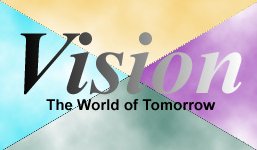
Vision
1.2. Towards A World-wide IT Infrastructure |
The current trends with respect to IT, telecommunications and consumer electronics show a growth towards a world-wide IT infrastructure, connecting people and companies professionally as well as privately. This IT infrastructure is the foundation for the breakthrough of the Information Revolution. In this section, we describe how this IT infrastructure will gradually develop, both with respect to size and with respect to facilities for those who use it.
1.2.1 Towards World-wide Companies
Companies are creating internal and external networks of computers. The internal networks connect personal workstations – terminals and personal computers (PCs) – and larger supporting computers such as the central mainframe and smaller computers of various departments. Externally, companies connect their computers via telecommunications to be able to exchange data faster and better link their business processes. More and more often, the PCs of employees and customers at home are included in the external network as workstations. Small, portable computers can be used very well as workstations while travelling. Equipment for mobile communication provide network connection for portable computers.
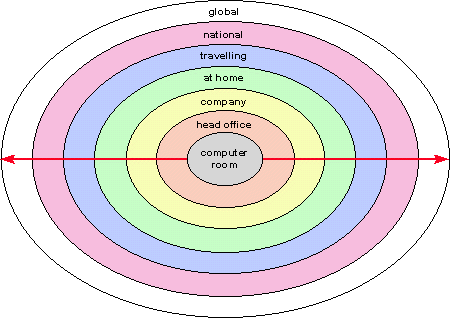
Figure 1.3 Towards a world-wide company. The networks gradually become larger. More and more computers of companies and private individuals, in buildings and on the road, are connected. Eventually, there will be one great world-wide network of computers, supporting great numbers of people in companies, at home and on the road.
As a result, the boundaries of the computer system of a company, and therefore the boundaries of the company itself, are formed less and less by the walls of the office. The range of the company grows, parallel to the growth of the external networks. Companies all over the world therefore find new ways of co-operating with other companies. All kinds of interorganisations are created. An interorganisation is a flexible co-operation between legally independent companies.
As organisations, companies no longer have physical boundaries. At present, we mainly have companies where employees physically go to work and where customers come to buy products. In future, there will be virtual companies, that no longer require employees and customers travel to the companies themselves. Employees anywhere in the world can work together in the company via the network, while customers anywhere in the world can order products and services via the network.The growth towards world-wide computer networks implies the growth towards companies and individuals operating and co-operating on a world-wide basis.
1.2.2 Integration Of IT, Consumer Electronics, Communication And The Media
Consumer electronics
Another impulse for the development of a world-wide IT infrastructure originates in the private domain. This makes the network very dense. More and more people use a personal computer at home. For little money this PC can be equipped with a modem, which makes communication with other networks possible. The possibilities of PCs are still growing. The latest development is that of multimedia on the PC. This provides the possibility to render moving images (television or film) and sound. As a result, people are using their PCs more and more for the same purposes as the present day consumer electronics, such as television, radio and CD player. The future will bring us an electronic home system, which integrates IT and consumer electronics and thus offers increasing possibilities. The home system has stations in various rooms, serving for work or entertainment. There are rooms where you can experience virtual reality films or listen to musical renditions. The system handles the energy supply and the climate control of the house and assists in doing the accounts.Communication
Network systems of companies and home systems will bring about the integration of various types of communication. All existing forms of telecommunications via telephone, television, radio and data communication will eventually integrate into one world-wide network, capable of transmitting enormous quantities of digital data. This is what we call the Digital Highway. It will support all forms of direct telecommunications between people and computer systems and all exchange of electronic data. The infrastructure of the network will probably consist of a world-wide glass fibre net, capable of transporting huge quantities of data. In addition to the glass fibre net, local station and satellites will handle mobile communication.
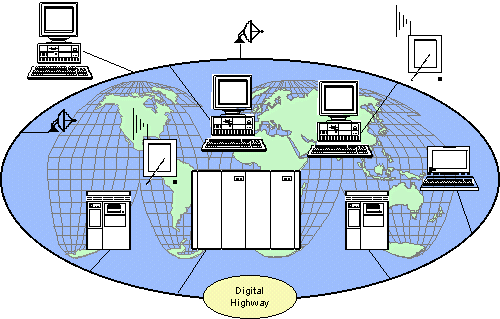
Figure 1.4 The world-wide IT infrastructure. Media
For media suppliers, the development of the Digital Highway and of home systems opens up new commercial opportunities. They can now offer the contents of newspapers, magazines, books, reference manuals, compact discs and radio and television broadcasting in electronic form via the network. The same applies to computer software, such as programmes and games. Instead of buying a CD, the customer selects a Brahms symphony from the electronic catalogue at home, and orders it from a media supplier in the network. The supplier sees to it that the symphony is sent to the home system of the customer in electronic form via the network. The home system renders the symphony from the speakers in the living room. Video on Demand is a first step in this development. The customer, by the way, does not have to passively watch and listen to what the media suppliers offer. The supplier provides the products as interactive ‘documents’. The user is free to decide in which order he will play the document, to temporarily stop using it or to repeat certain parts. The customer pays for this service. We assume that the customer will basically pay for the use of the documents – the eternal use, if necessary – not for the ownership of the documents. This means that the supplier ‘broadcasts’ the documents for direct rendition by the home system. He does not ‘send’ an electronic copy, to be stored and used on the home system. Television and radio broadcasting as we know it – continuous broadcasting on air and on cable – will eventually disappear. Instead, media suppliers will broadcast information, films and music on demand to the customer’s home or mobile system.Immaterial products become truly immaterial in this way, for the material bearers of data as we know them now, such as books that contain novels, CDs that contain pieces of music or videotapes that contain films, will disappear for the major part. Suppliers of messages, information, novels, articles, music, films and educational material will in future represent these immaterial products on their customers’ home computer systems via the Digital Highway.
Co-operation
The world-wide IT infrastructure will be realised through a close co-operation between suppliers of IT, consumer electronics, media and telecommunications services. We already see the first alliances between these companies. Eventually, there will be one information and communication industry, concentrating on organising and operating the IT infrastructure and on the supply of immaterial products.The IT infrastructure requires massive investments in computer systems and networks. The Digital Highway will require a great transmission capacity. People and companies must be able to offer, broadcast and send to each other multimedia documents world-wide. The present networks are insufficient for this. The realisation of a world-wide Digital Highway and a world-wide computer network will therefore take at least 15 and perhaps 25 years.
1.2.3 From Data Via Documents To Realistic Objects
The possibilities to represent reality by means of data in the form of alphanumeric fields are too limited. This data format only consists of 26 characters, 10 digits and several special characters. It is only suitable for recording and transmitting a certain kind of formal data, such as features, brief descriptions and numbers. The major part of the data currently stored in business computer systems consists of (a binary coding of ) these alphanumeric data, with all the restrictions that go with it. The current trend towards object-oriented application development will continue. In the coming years, electronic data in the form of alphanumeric fields will be converted into electronic ‘objects’ such as texts, drawings and images. In these objects, both the contents (data) of an object and its behaviour (the software) are contained and recorded in binary code. The behaviour includes functions such as representing the contents of the object on screens, editing of the object by the user and storing the object in a database. As a result of their way of presentation, these objects have a much larger realistic value.

Figure 1.5 Increasing realistic value of electronic data. The increase in realistic value is related to the development of the user interfaces of computer systems. The terminals of central systems and the first generations of PCs are all equipped with Character User Interfaces (CUI) that allow for the presentation of a limited number of alphanumeric fields or simple text. Meanwhile, the Graphical User Interface (GUI) is becoming increasingly popular, especially since many users of PCs have started to use Microsoft Windows. With the GUI, the user obtains the on-screen presentation of formatted text, drawings, still images and sound. Since the introduction of multimedia, users are starting to extend their PCs with interfaces for the presentation of moving images (video) and stereo sound and for the editing and synthesis of images and sound. The GUI is thus extended into a Multimedia User Interface (MUI).
Multimedia
Multimedia is the generic term for the technology involved with the integrated processing and presentation of all forms of electronic data such as text, images and sound. Multimedia works with electronic documents that may contain all these different forms of electronic objects. Multimedia documents therefore offer far more possibilities than common alphanumeric data, since they are not only capable of containing text and drawings but can also contain a combination of sound, still images and even moving images. Of course, this matches human vision and hearing in a much better way, which makes multimedia documents extremely suitable for knowledge transfer.The development towards multimedia also has consequences for human/computer interaction. In conventional CUI applications the application decides which alphanumeric fields appear on screen and what the user is allowed to fill in. The user himself only has limited possibilities to determine the order in which the required screens appear. The GUI, and especially the MUI give the user more freedom in this area. The application is an electronic document containing electronic objects such as texts and drawings. The user uses these documents and is able to modify the objects contained in them. The user is provided with more different ways of interaction and on top of that he has more freedom to determine the order of his own work.
Virtual reality
The realistic value of electronic objects may be even further enhanced in time. The information technology to facilitate this is called virtual reality. Virtual reality focuses on realistic electronic objects which let the user experience a certain situation as realistically as possible. This situation might be created artificially or it might be recorded at a different time and place than the time and place of rendition. The aim is to eventually realise the Human User Interface (HUI). This is an interface that closely connects to the human senses and motor system. With this interface, the user will hardly experience a different reality from the one offered to him by the computer. To achieve this, vision and hearing require a realistic, three-dimensional rendition of images and sound. The senses of touch, warmth, equilibrium and the motor system require simulation of movement, pressure and warmth. The way the computer connects to the human motor system will also have to be improved considerably. The current keyboards and mice are totally insufficient. Moreover, simulation of smell and taste might be considered.Virtual reality strongly appeals to the imagination. There are a number of important possibilities for its application. With this technique, people are able to communicate long-distance while seemingly having a personal, face to face conversation. Operators can monitor processes from a distance as if they are actually present. Real-life events can be represented true to life after they have happened, or be simulated before they actually happen. It is also possible to render realities which are invisible, inaudible or intangible to our own senses. Take for example infrared pictures or X-ray pictures. With special equipment, such realities can be observed and recorded. Such a hidden reality is called a hyperreality.
Virtual reality may contribute significantly to the success of learning processes. People learn best through their own experience. Unfortunately, in everyday reality this own experience is not always without danger. By means of virtual reality, people can gain experience without physical danger by seemingly living through situations. This is already the case with flight simulators.
Direct communication
The best way to convey knowledge is not via books or electronic objects, however realistic they may be, the best way still is direct, face-to-face communication between people. Body language, gestures, the atmosphere in which the conversation takes place all enhance the communication. The dialogue between people provides excellent support for the joint conception and design of new things.Telephone and videophone allow for the direct communication between people in different locations. If more than two people consult or conference with each other in this way, this is called teleconferencing or videoconferencing. If, on top of that, the people who are communicating look into each others documents via the network and the workstations, the communication can be enhanced even further. One participant may for example sketch a design which the other participant may complete.
Increase of data and knowledge
Multimedia and virtual reality offer an enormous expansion of possibilities. The wealth of electronic data surpasses that of all older forms of recording of data. Multimedia and virtual reality thus confirm an existing trend: the growth of the amount of recorded data at our disposal.
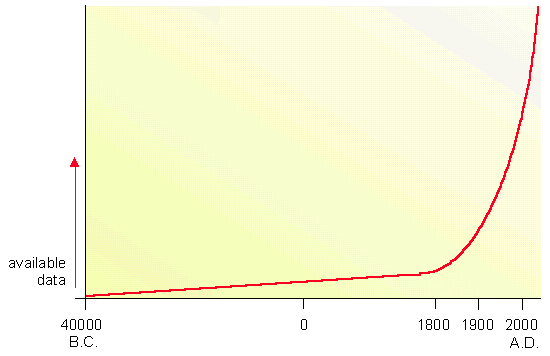
Figure 1.6 The growing amount of available data. In the evolution of mankind, the invention of the script caused the first boost in available recorded data. The invention of printing, at around 1440, causes further growth. People’s knowledge increases thanks to the improved distribution of information through books. More and more people build up new knowledge of their own which they distribute in the form of books. This growing scientific and technical knowledge leads to the Industrial Revolution, towards the end of the nineteenth century. The Industrial Revolution in turn contributes to a further acceleration of the distribution of information and the growth of knowledge. Particularly over the past 150 years, we can see the pace at which the number of available data grows increases ever more rapidly.
The Information Revolution will again accelerate this pace, even when many people cannot or only just keep up with the current pace. It may not be as bad as all that, considering the fact that the representation of recorded data by means of virtual reality will have greater realistic value. Our knowledge about and understanding of situations, such as the working of processes and organisations, will be enhanced by more realistic representation. We will also have to use IT to sort and select from the enormous quantities of data at our disposal. The amount will be so great it will be impossible for us to have an overall view. Many stored data are already hardly accessible, and have therefore become useless. IT also helps to better associate data in various areas with each other. This is a great help, both to discover and learn new knowledge and to recognise and unlearn existing incorrect knowledge.
1.2.4 Moving From Formal To Informal And Creative
The developments described above will significantly change the nature of business applications on the computer. The present business applications are of a distinctly formal nature. The data are mostly alphanumeric fields and the processes are formally prescribed as programmes. The conventional development methods confirm this formal nature by aiming for programmes that are evidently correct, and for consistency of the data stored in the database. This method gives information sciences a rational and mechanistic nature. New developments in IT are changing this. With multimedia, besides structured data, unstructured data can also be stored, made accessible and related in a playful manner. This allows people to work in a less formal and more intuitive way.
In the coming years, besides specific business related custom applications, more and more generic applications will come into use. They will support informal and creative tasks. Custom applications support employees in performing specific tasks, while generic applications support them in general forms of working and co-operating. Generic applications are for example word processors, drawing tools and software for electronic mail and teleconferencing.
The new applications do not just support the routine business processes. The present, formal applications are often aimed at automating routine jobs, in which the computer replaces the employee. New applications are aimed much more at supporting formal and informal tasks, at collaboration between colleagues and at creative tasks, such as designing a new product. The new applications are not primarily meant to replace people and enhance efficiency, but to offer people more possibilities to perform their work creatively and effectively.
1.2.5 From Programme To Object
The conventional way of software development will radically change. Custom software will eventually no longer be constructed line-by-line. With the use of the object-oriented way of construction, software will no longer consist of complete packages or of monolithic custom systems, but of separate, generic and specific software building-blocks, called objects. These objects can be copied, modified and combined into complete applications in many different ways.
Software vendors will in future offer package software as separate building blocks. The user will no longer buy one large word processing package, such as the present Microsoft Word or WordPerfect, including for example drawing tools and text formatting tools. No, the user decides himself which generic objects (texts, drawings) he will be using in his electronic documents. He buys the separate ‘parts and tools’ for functions such as word processing, drawing and page formatting. With these parts, he constructs his own package. A user who draws frequently will buy additional drawing tools and a user who works in different languages buys extra translation tools and spelling checkers.
An increasing number of specific software objects will be available as ‘building blocks’, from which the software developer will construct the custom software for a specific sector. Take for example electronic ‘objects’ that are particularly suitable for specific areas of application like the world of finance, administrative organisations or industrial process control.
Programming becomes a task of the software factories, that will supply the software for the specific and generic objects. Instead of programming, the developer, or maybe even the user himself, will construct custom applications from objects. If certain objects are missing, a new component can be ordered from the software factory. The generic objects support common tasks, such as word processing, electronic mail and teleconferencing. By combining specific and generic objects, applications are constructed that have both formal and informal features. Only one or two specific objects will need to be made exclusively for that particular application.
As a result, computer systems of the future will contain less structure and more infrastructure than the present, central systems. Not only will the technical infrastructure, consisting of hardware, networks and basic software, be more extensive; the application software of the future will for the main part consist of a collection of generic software (building blocks) that support common tasks. Only a small part of the application software will consist of structured, company-specific software (building blocks). As a result of this, the speed at which applications are developed and modified will increase significantly. Until recently, the possibilities of the hardware grew more rapidly than those of the software. The new, object-oriented way of working removes an important barrier for the further growth of applications.
1.2.6 Summary
The development of interfaces towards a form of human/computer interaction which connects to the human senses and motor system more effectively, makes it easier to work with computers. The formal business applications, requiring specific skills from the user, are developing into applications that support informal and formal tasks of all employees. Interactive multimedia documents facilitate data formats that are accessible to every consumer. Virtual reality will yield realistic electronic objects everybody will be able to work with.
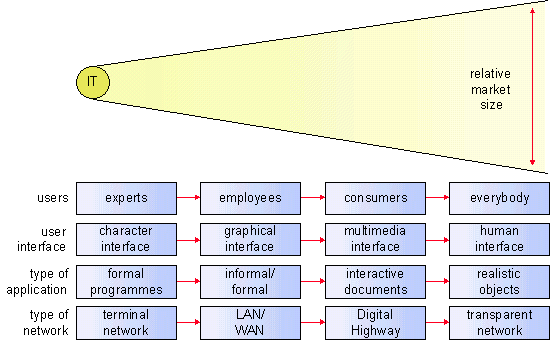
Figure 1.7 The growing IT market. Meanwhile, the scope of applications is also widening. In companies, the conventional terminal networks with central computers are making way for internal networks consisting of server computers and personal workstations for the employees. External networks between the computer systems of companies are also emerging. One of the next phases will be the Digital Highway that will soon connect companies and private individuals. People will have home systems in the form of networks connecting all kinds of hardware in their homes. Eventually, the network will become fully transparent for the users. By means of the sophisticated user interfaces on their computers, everybody will, without bothering about the network, be able to have realities rendered that happen at different places and different times.
The trends mentioned imply that the IT market has a great potential for growth. The amount of computer and network hardware, the number of applications and in particular the number of users will yet grow tremendously.